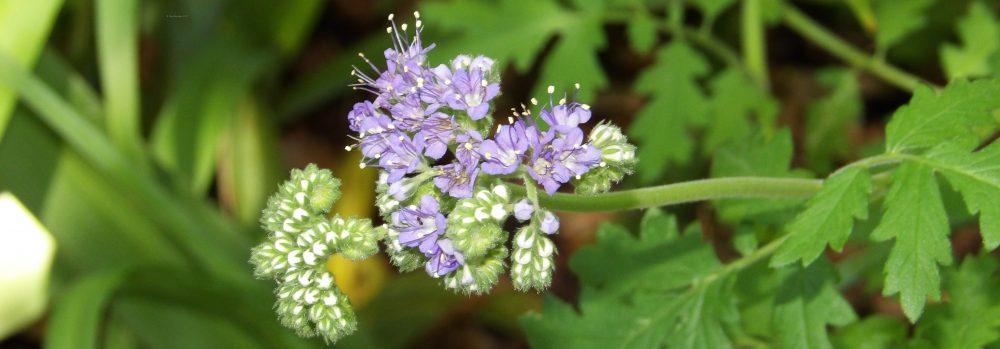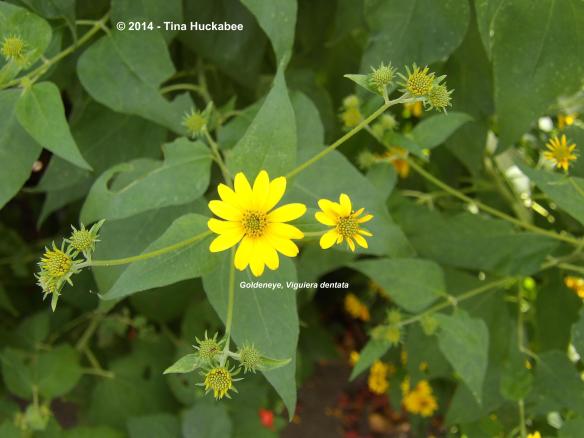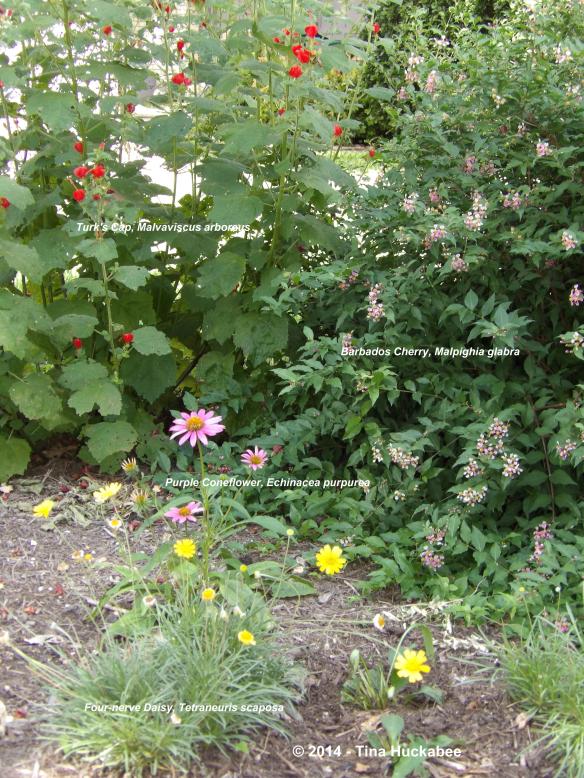This week, October 19-25, is dedicated to celebrating home-grown native plants in geologically, topographically, and meteorologically diverse Texas. My experience in gardening is limited mostly to urban gardens in Austin, but I also have limited knowledge about plants along the central Texas coast, owing to having grown up in that area.
Texas is a big place–a really big place.
Natives that are completely at home in my gardens may not fare so well in the Panhandle or The Valley. What works well in the High Desert mountains of West Texas definitely won’t like the humidity, drippy rain, and acidic soils of the East Texas Piney Woods. Native to here isn’t necessarily native to there. Yes, there are crossover plants which thrive in vastly differing situations and there are plants which flourish worldwide. I certainly grow some plants in my gardens whose ancestors originated halfway around the world. But when a gardener uses native plants, several valuable and aesthetic goals are accomplished.
Native plants impart a sense of place. My garden looks different from a garden in the Northeast or the Pacific Northwest–and it should. What grows for me should be different from what someone in Minnesota grows. A home or commercial landscape in Arizona shouldn’t host the same plants as a garden in South Carolina. Some natives exist only in a very specific area, while others range throughout much of North America, but all suggest a regionalism that defines a specific climate and geography–native plants identify place.
Native plants require less irrigation and less chemical intervention. Because native plants grow where they evolved, there’s no extra work in keeping native plants alive-except planting or seeding out the darn things, of course. Other than some watering immediately after planting, a native perennial or annual usually survives without extra effort–extra watering, extra fertilizing, or extra babying. The only plants I feed in my gardens are the pond plants and the roses; the entire process takes about 15 minutes, once per month. I haven’t used any herbicide or other chemicals–well, I don’t think I’ve ever used a herbicide, and the last time I used a commercial fertilizer, excepting the aforementioned plants, was when I still had turf–and that’s some years ago. I do irrigate, sparingly, June-August, but that’s all the irrigation I give to my perennial gardens.
For Texans who are happily riding on the native plants bandwagon, our primary gardening efforts tend to be in the winter and early spring–pruning, mulching, and readying our gardens for the long growing season. Landscaping with native plants does require some work–they seed out (prolifically at times) and for the sake of tidiness, occasional pruning is a must. But the differential between landscaping with turf versus native plants is huge. When I observe the mowers in spring, summer, and fall, often perspiring as they pointlessly mow, edge, water and feed their grass–I’m befuddled. Why would you have grass, which requires weekly (or nearly weekly) maintenance, when there are so many beautiful, really beautiful, perennials, grasses, and annuals requiring little maintenance? What is the point of watering and fertilizing something, just so it can be mowed? I used to have grass and only grass. I used to mow, water, edge, fertilize–the whole absurd merry-go-round futility of turf–until I transformed my personal landscape with (primarily) native plants.
Not everything in my garden is native–I grow plenty of native cultivars and non-native plants and they are some of my favorites. But native plants are special–born and bred here in Texas. They are easy, lovely, and Texan and it doesn’t get better than that! If you live elsewhere, then your native plants are easy, lovely, and…emblematic of the wonderful and special place that you live–wherever that might be.
Native plants feed wildlife. The synchronicity of native plants with their pollinators and other wildlife partners is an established biological paradigm. In any given area, wildlife evolved along with their plant hosts–it’s just that simple. When you have native plants in your gardens, you will attract wildlife. Boom! The home gardener can play an important role in providing for wildlife by planting natives: as large swaths of land are destroyed for a variety of reasons, why not help heal the world, in a way that is very real and practical, by planting natives which will feed displaced wildlife?
I putter in my gardens–constantly reviewing, reassesing, and replanting. Gardening is my passion, it’s what I do. I recognize that not everyone is a gardener and most are unlikely to do what I’ve done. I have been called “crazy” more than once by those who don’t get what I’ve done with my “yard.” However, I can’t help but wonder what would happen with our beleaguered and threatened natural world if everyone who owns property, the proverbial house with yard, would take out half, just half, of their useless and wasteful turf and install native plants instead. Think of how unique each home garden could be. Think of the water which would be conserved. Think of the fossil fuel which would not be used. Think of the wildlife which would be fed. Think of the locally owned nursery and landscape businesses which would boast more clients, rather than the large mowing companies and the big box stores siphoning off that work.
I don’t see a downside to using native plants in the garden. One difficulty you might encounter is if you live where the local nurseries don’t yet provide a selection of native-to-your-area plants, you’ll need to request they do. Business axiom dictates that if customers demand products, businesses will provide those products. It may take time and persistence, but the native plants ship is sailing and the savvy nursery owner or landscaper will climb aboard.
This coming week, I’ll be profiling a fraction of the natives that I grow in my garden. These plants are perennials that are doing something “now”–blooming or berrying or generally looking good. Readers from elsewhere–you might be bored with this week’s posts, as I’m writing primarily for Texas viewers. Hopefully though, you’ll be encouraged to discover what is native in your areas–many places now celebrate the use of native plants in home and commercial gardens.
Native plants work. They are beautiful, unique to region, and typically hardy and drought-tolerant. There are many resources available to learn about native plants and their value; you can start by checking out the “Garden References” section on this blog’s menu.
For more information about Texas Native Plant Week, take a look at the websites of the following organizations:
Lady Bird Johnson Wildflower Center
Texas Parks and Wildlife Department
Go natives!





















I noted weeks ago (when I felt it was still “too soon” to do anything) the celebration of Native Plants scheduled for 10/19 and beyond. I was sitting down to prep a post this morning when yours popped up. Now? Now I honestly see no point in doing anything other than linking to your incredibly thoughtful post here and writing “what SHE said…”.
Happy Native Plants Week!
LikeLike
Oh, please! You just go right ahead, Deb and post away! You’re one of the converted–tell your story! You live in the perfect spot for natives: you share your space with deer, you tolerate thin soil and share something in common with the rest of us sweaty Texans–the long and hot summers. You’ve learned how valuable native plants are in your spot of the Earth and are accommodating that knowledge accordingly. And, you’re a terrific writer! Happy Natives to you!
LikeLike
I kind of agree with Deb. I feel like one of those extras in a Xena episode, “Listen to her! She’s right!” heh
Native plants do impart a sense of place. This is a land of flowers. A place meant to be a cottage garden. How could anyone think a monoculture lawn would be preferable? The mind boggles. I admit we still have a bit of lawn left but each year I chip away. What is causing the delay? Cost and finding plants I want that will do more than merely live in deep shade — I want plants that will thrive.
The other thing you said about the synchronicity of native plants and wildlife really speaks to me. Only this year I learned about flight times for various insects. That eight spotted foresters and orchard bees only fly for brief periods each year and then go dormant or die. I assume their presence is connected to the plants they need for their survival. The complexity of that kind of interconnectedness fills my heart with all kinds of appreciation.
LikeLike
Ha,ha! Those blogging Deb/Debras in my life–such funny women. The mind does indeed boggle (and I’m considered the weird one…). Shade is hard. But there is a quiet beauty in a mulched area in deep shade, punctuated by the few structural (and fewer flowering) shrubs which will work. It takes time to get rid of the lawn, but you’re on the way.
When my children were very young, we had the chance to spend some time in London and we visited the Museum of Natural History where there was an incredible exhibit on insects. I’ve never seen a better explanation of how bees, butterflies, birds, etc., “see” the various flowers and how they hone in on what to nectar from and pollinate. One of the things that resonated was that the little dots and lines that you can see in flowers evolved as “landing strips” of sorts for the critters. So, not only are those intricate designs beautiful, they have a purpose. Simple, yet profound.
LikeLike
Great post, Tina! I agree with you all the way. I’ve been adding mostly native plants to my garden, and the previous owners had already landscaped with many of them, too. Now that we’re thinking of moving in the next few years, I’m holding back a bit on investing in tons of new plants. But, God-willing, the next property will be a continuation of my focus on mostly native plants for the garden. I use only organic gardening methods. You’re right about the wildlife–they visit a pesticide/herbicide-free, mostly native plant garden in droves. 🙂
LikeLike
Critters are smart, aren’t they? They know what’s good to eat! I think most conscientious gardeners do what we’ve done–focus on what grows where we are, rather than attempting to force something that doesn’t belong. Gardening with native plants is good all the way ’round: natives conserve water, don’t require pesticides or herbicides, and they’re beautiful. What’s not to love about that?
LikeLike
I loved this post..so much so that I’ve linked it on my blog. We have so many wonderful native plants to choose from in Texas it helps to learn there are plants that can survive our weather, soil and everything else we throw at them.
LikeLike
Awe, thanks Shirley! With the relandscaping of garden, you know as well at anyone how great natives are for our challenging region. Native plants work–in our weather, soil and all else.
LikeLike
Very nice post! So true regarding plants that might thrive on the coast or eastern parts of the state but won’t even grow in other parts. Living in north Texas, I wish I could have some of the beautiful plants I see elsewhere in the state, but our hot temps and dry conditions just won’t allow them! A gardener needs to pay close attention to what actually grows in her garden, what thrives in the conditions available, and use those plants as much as possible. Our backyard went south with the drought. We have one tiny six-by-six area of grass under a tree. The rest is bare but being slowly nurtured back with native plants. I’m hoping that someday it will look like a jungle. It’s a slow process if you do it yourself, but very well worth it. One thing I do that I believe helps out a lot is recycle leaves. During the fall and winter, as leaves shed, I mulch them with the mower and collect them in the mower bag, then spread them throughout the back yard. It’s small enough that the whole area receives a good layer. The plants love it, the birds and squirrels enjoy digging in the leaves, and the ground gets some good nourishment. Thanks again for your great blog.
LikeLike
Thank you! All the best with your re-landscaping efforts! You’re on target when you use mulched leaves in the garden–there is no downside and recycling them for your gardens keeps the bagged leaves out of your local landfill–and that’s a very good thing. There are many lovely natives appropriate for North Texas–lots of grasses and prairie plants–I urge you to utilized those in your gardens. Take some photos and keep in touch; I’d love to see your progress!
LikeLike
Pingback: Texas Native Plant Week | My Gardener Says…